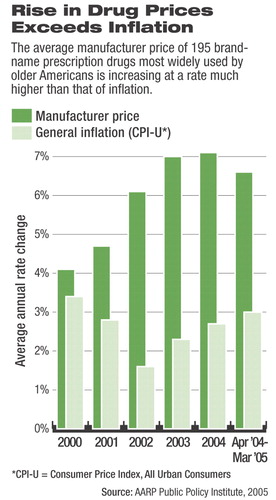Psychiatric Drug-Cost Growth Far Outpaces Inflation Rate
The average prices of drugs commonly used by older Americans—including some psychiatric medications—are increasing at a substantially greater rate than that of general inflation.
Manufacturer prices for 110 of the 195 most widely used brand-name prescription drugs increased from December 31, 2004, through March 31, 2005, according to a report by AARP (formerly the American Association of Retired Persons).
All increases were 2.9 percent or more, about triple the rate of inflation of 1 percent for the same period, according to the report.
Report author David Gross told Psychiatric News that among the 110 drugs were Paxil, Wellbutrin, and Zoloft, which all increased in price by 2.9 percent, and Effexor, which increased by 5.9 percent.
The report was prepared by the AARP Public Policy Institute in conjunction with the PRIME Institute of the University of Minnesota as part of a continuing series of analyses of prescription drug prices.
In addition to the first-quarter changes, AARP also reported changes in drug prices from March 2004 to March 2005. Average prices for the 195 top brand-name drugs rose 6.6 percent during that period, or more than twice the 3 percent rate of general inflation, according to the report.
As a result of these increases, an older American who takes three prescription drugs is likely to have experienced an average increased cost of $866.16 from 2000 through March 31, 2005, if the drugs are brand-name products used to treat chronic conditions and the full price increases were passed along to the consumer, according to AARP.
By comparison, the cost of a sample of 75 generic drugs rose by only 0.7 percent in the 12 months ending on March 31, 2005. While this is a slight increase over that of the 12-month period ending on December 31, 2004, it represents a substantial slowing compared with the dramatic rates of increase for 2001 (7.8 percent), 2002 (15.8 percent), and 2003 (13.3 percent). Furthermore, the report stated that in the first quarter of 2005, the manufacturer list price of only three of the 75 generic drugs in the sample had increased.
“We are very disappointed that brand-name manufacturers have failed to keep their price increases in line with inflation, and we will continue to educate our members and the public about how best to find the most affordable prescription drugs to suit their needs,” said AARP CEO William Novelli.

“Trends in Manufacturer Prices of Brand Name Prescription Drugs Used by Older Americans—First Quarter 2005 Update” is posted at<http://assets.aarp.org/rgcenter/health/dd121_drugprices.pdf>.▪



